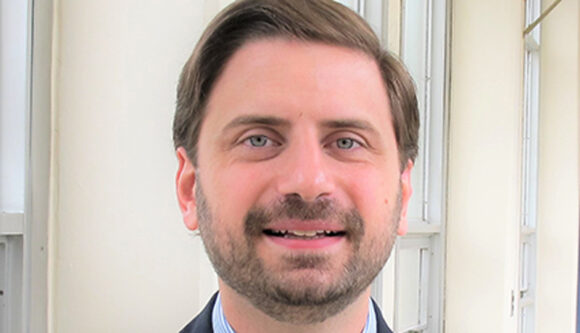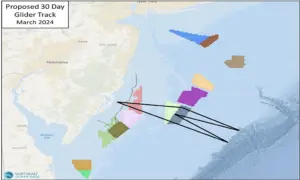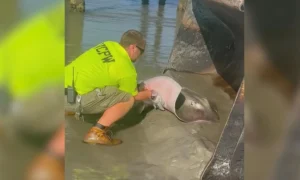Multidisciplinary collaboration involving three schools and multiple departments will combine efforts of environmental and marine scientists as well as engineers
A Rutgers research project focused on offshore wind energy is poised to make New Jersey a global leader in the field in a little more than a decade.
The effort being launched by Rutgers researchers includes two key components: The design of a so-called Net-Zero Wind Energy Test (WET) Center, a warehouse-size testing facility to be potentially located somewhere close to the Jersey Shore; and the creation of a much smaller WET Lab which will be located on the Rutgers University–New Brunswick campus.

Rutgers–New Brunswick Chancellor Francine Conway says new efforts in wind energy research focus on a “grand challenge of science and society.”
The new venture, which aims to address scientific and engineering challenges in testing a floating offshore wind turbine, will position Rutgers at the center of what is expected to be one of the most ambitious wind power research projects in the United States.
The project is one of four winning proposals selected for funding in March 2023 by Rutgers–New Brunswick Chancellor Francine Conway as part of her Chancellor Challenge fostering the development of transformational, campus-wide initiatives to fulfill the goals of Rutgers-New Brunswick’s Academic Master Plan.
“This outstanding project was selected through a rigorous, competitive review of proposals to catalyze exploration, collaboration, concept-testing and risk-taking,” Conway said. “Its success will rest on the efforts of cross-disciplinary teams from multiple Rutgers–New Brunswick units. Importantly, it focuses the power of our research on a grand challenge of science and society.”
The effort will capitalize on a surge of support for wind energy, including public funds that Gov. Phil Murphy invested into wind power development through the Wind Institute for Innovation and Training.

The project will make Rutgers globally known for wind research, says Onur Bilgen, a leader of the project and an associate professor in the Department of Mechanical and Aerospace Engineering. Photo:
Rutgers School of Engineering
“Our broad vision is that, by 2035, New Jersey will be among the global leaders in offshore wind energy research, technology development and testing, and that Rutgers will be globally known for its multidisciplinary approach to the economics, engineering and the social and environmental science and policy of wind energy,” said Onur Bilgen, an associate professor in the Department of Mechanical and Aerospace Engineering in the Rutgers School of Engineering (SOE.)
Bilgen is leading the project with Josh Kohut, co-founder of the Center for Ocean Observing Leadership and a professor in the Department of Marine and Coastal Sciences in the Rutgers School of Environmental and Biological Sciences (SEBS.)
The effort will receive about $1.1 million from the Rutgers–New Brunswick Chancellor’s Office.
The WET Center is one of the first flagship interdisciplinary projects of the newly created Rutgers Climate and Energy Institute (RCEI), announced by Conway in October, and which is another initiative of Rutgers–New Brunswick’s Academic Master Plan.

The WET Center is a “signature investment” for the university, says Julie Lockwood, interim director of the Rutgers Climate and Energy Institute.
Photo: Rutgers Climate and Energy Center
“The WET Center is a signature investment into cutting-edge climate change and renewable energy scholarship and education through RCEI,” said Julie Lockwood, RCEI’s interim director and a professor in the Department of Ecology, Evolution and Natural Resources at SEBS. “Its innovative design fosters collaboration among scholars from a variety of academic fields, which enhances the impact of Rutgers on next-generation wind energy production.”
Studying offshore wind energy systems – constellations of turbines installed in the ocean as opposed to land – offers a unique opportunity to build bridges across campuses, Bilgen said. Wind energy systems, especially offshore, are more expensive to install and maintain than land-based wind energy and conventional energy sources. But there have been several recent technological advances that may change that, including the development of multidisciplinary design optimization tools; new light and strong composite materials, structures and coatings; and manufacturing and installation methods.
Concentrated, collaborative efforts will continue to yield further innovations, Bilgen said.
In the organizers’ vision for the larger test facility called WET Center, which will require governmental and industry support to build and operate, researchers will be able to test near-full-scale versions of Eiffel Tower-size wind turbines designed to float in the deep ocean, Bilgen said.
Researchers working at the smaller WET Lab will be able to test much smaller versions of the giant machines. That facility also will be the center of efforts to give rise to and foster new interdisciplinary collaborations among faculty and students. Those leading the effort will develop and implement a laboratory course and course modules for integration into existing courses.

Josh Kohut, a professor in the Department of Marine and Coastal Sciences, will co-lead the project. The effort will engage a large cohort of engineering and marine science researchers. Photo: Rutgers Center for Ocean Observing Leadership
Kohut, a marine scientist, praised Bilgen for developing the concept of a research facility for offshore wind power and engaging so many faculty members with diverse interests.
“Onur had this really great idea of planning for a research facility necessary for advancing offshore wind in the region – and he generously engaged all the groups that were working in that space,” said Kohut. “There’s something like 60 faculty members across the university who are engaged in some aspect of offshore wind. The WET Lab that will be put together through this effort will engage the engineering and marine science researchers of this broader Rutgers offshore wind community at Rutgers.”
Faculty from SOE, SEBS, and the Rutgers School of Arts and Sciences will be involved in center research. In addition to Bilgen and Kohut, five other faculty members, spanning multiple departments, will play critical roles in the effort.
Participating faculty from SOE include: Assistant Professor Laurent Burlion in the Department of Mechanical and Aerospace Engineering; Assistant Professor Aziz Ezzat in the Department of Industrial Engineering; and Assistant Professor Roger Wang in the Department of Civil and Environmental Engineering.
Those participating from SEBS include: Assistant Professor Travis Miles; as well as Rutgers EcoComplex Director Serpil Guran.
Bilgen said the future of wind energy is partially in floating offshore wind turbines. Large turbines are aerodynamically more efficient and can produce greater power. Making them, transporting and installing them are among key challenges.
“Offshore wind turbines are among the tallest structures in the world,” he said. “Apart from their increasing size, they may also have to be located in deeper waters, away from the shoreline to benefit from steady and stronger winds, and to minimize impact to coastal communities.”
Such floating structures pose many multidisciplinary design challenges in areas that touch upon expertise in many fields such as engineering, economics, environmental science, and energy policy. Multidisciplinary modeling and design optimization approaches will aid researchers in objectively considering all challenges. “Our research efforts and others occurring worldwide are making us better and better in designing every day,” he said.
Efforts to understand how best to install wind turbines in the deep ocean also will draw upon the extensive knowledge of Rutgers marine scientists.
“There have been a lot of questions raised about what effect putting structures in the ocean might have on ocean circulation, and ocean processes that are important to ecology, fisheries and marine mammals,” Kohut said. “All of those important questions can now be addressed in collaboration with the engineering faculty at Rutgers. We will be able to think about the whole picture, from the structure itself to its impact on the ocean environment.”
This article first appeared in Rutgers Today.




